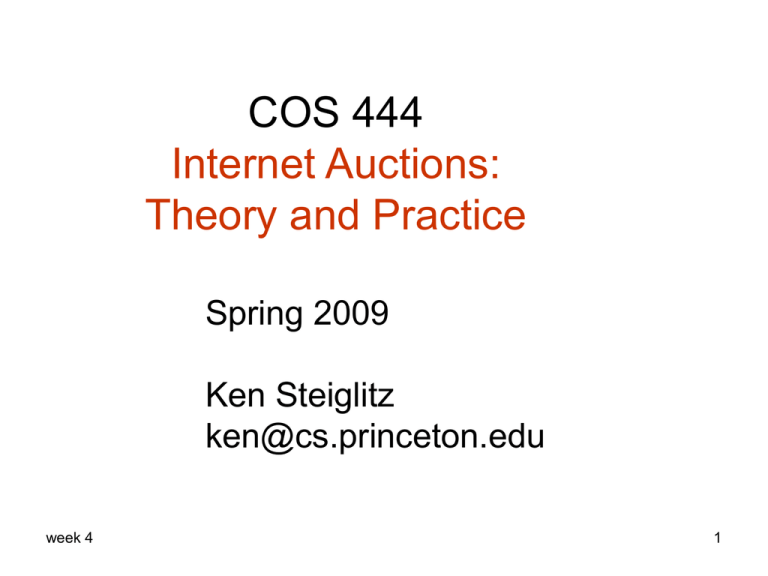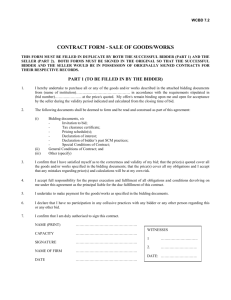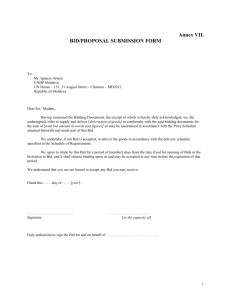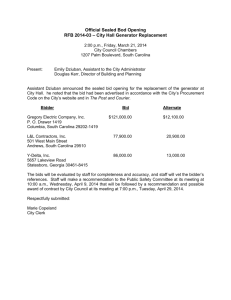Document
advertisement

COS 444
Internet Auctions:
Theory and Practice
Spring 2009
Ken Steiglitz
ken@cs.princeton.edu
week 4
1
FP equilibrium for general v distribution
The set up:
• Baseline IPV model, values iid with cdf F(v)
• E[surplus of 1] = pr{1 wins} (v1 – b(v1 ))
• Bidders 2,…,n bid b (v)
• What is best b( v1 ) ?
week 4
2
In bid space…
We need to express the prob. that 1 wins,
which is
pr{b (vi ) b(v1 )} pr{vi b (b(v1 )) F ( b (b(v1 ))),
1
1
i 2,..., n
For this, we assume for now that β is
monotonically increasing, and hence
invertible. We thus need to check our
answer!
week 4
3
Because the v ’s are independent, we can now write
E[surplus ] (v1 b(v1 )) F ( b (b(v1 )))
1
n1
and the equilbrium condition is then
E[surplus ] / b b ( v ) b ( v ) 0
week 4
4
One more thing:
When we differentiate this, we’ll need the
derivative of β-1 .
If you rotate the picture it’s (almost)
obvious that
( b (b))
1
week 4
1
1
b ( b (b))
5
Use chain rule, set β=b, use v instead
Of v1 , so β-1(b(v1)) = v.
Leads to a linear, first-order
differential equation for b(v):
b [( n 1) f (v) / F (v)]b [( n 1) f (v) / F (v)]v
This is of the form:
b(v) C (v)b(v) D(v)
week 4
6
Use the ancient trick of multiplying by the
integrating factor
C ( v ) dv
e
Cdv
Cdv
Cdv
be
bCe
De
Cdv
d Cdv
be De
dv
be
Cdv
week 4
Cdv
Cdv
De dv e
7
In this case, C=(n-1)f/F; D=vC; and
Cdv
e
e
( n1) f
F
dv F
n1
Integrate by parts, use b(0)=0 to determine
γ=0.
Solution: (check monotonicity assumption)
v
b (v ) v F ( y )
0
( n 1)
dy / F (v)
( n 1)
…optimal shade
week 4
8
To check monotonicity assumption:
From the differential equation:
b [( n 1) f (v) / F (v)] b [( n 1) f (v) / F (v)]v
week 4
(n 1) f
b
(v b ) 0
F
11
eBay observed
• Assignment 2 provides a tool for
visualizing behavior…
• We’ll look at some examples, but first…
week 4
12
eBay’s algorithm
• Open vs. secret reserve
• Increments
• Raising your own (highest) bid when
you're less than a bidding increment
above the posted second price
• Raising your own (highest) bid when you’re
below secret reserve
• Buy-it-Now with and without offer invitation, and
with and without bidding opportunity at lower
reserve, when bids will remove buy-it-now.
Question: is it rational to bid above buy-it-now?
week 4
13
Simplest case: Open reserve (minimum bid)
Assume for simplicity that bidding
increment = tick = $1; open reserve = $10
First bid: $20
Posted:
$10
Minimum next bid is this + tick = $11
New bid and bidder: $15
Posted:
$16 (“proxy bid”)
Minimum next bid is this + tick = $17
New bid: $19.90
Posted:
$ 20.00 (“proxy” can’t exceed high bid)
Minimum next bid is this + tick = $21.00
week 4
*In all cases the posted price is the one paid
14
If instead:
First bid: $20
Posted:
$10
Minimum next bid is this + tick = $11
New bid and bidder: $15
Posted:
$16
Minimum next bid is this + tick = $17
New bid: $20.10
Posted:
$20.10 would pay
Minimum next bid is this + tick = $21.10
New bid by high bidder:
$24.00
Posted:
$21.00 now pays (basis of law suit!)
Minimum next bid is this + tick = $22.00
week 4
15
With a secret reserve, say $100
First bid: $20
Posted:
$20 and “reserve not met”
Minimum next bid is this + tick = $21
Further bids: treated as usual if secret reserve not met,
with the warning “reserve not met”. (High bidder does not
bid against herself.) If and when secret reserve is met,
highest bidder’s bid is hidden and (formerly secret)
reserve is posted, plus “reserve met”.
week 4
16
The inside of the algorithm
After (open or secret) reserve is met:
H = max { H, acceptable bid by new bidder }
… tie keeps the same high bidder
L = min { H, acceptable bid by new bidder }
posted price = min {L + tick, H }
week 4
17
Early bidding vs. Sniping
• But early bidding
affects behavior
WAR
week 4
18
Dangers of early bidding, con’t
As bait
week 4
20
Dangers of early bidding, con’t
Curiosity
week 4
22
A (likely) shill
Reserve = $95 ______
• Bidder 3 bids
$94 when the
reserve is
$95 and the
high bid is
below that.
She has
feedback of
1. A likely
shill.
week 4
24
First-price equil. derivation in value space
A slicker way to do business, the way the
pros do it: If the assumed monotonically
increasing bidding function is b(v) , then bid
as if your value is z. The equil. condition is
then
E[surplus ] / z z v 0
where now
E[surplus] [v b( z )]F ( z )
week 4
n1
26
The rest is now much easier
Differentiating wrt z :
(n 1)[v b]F
n 2
n1
f b F 0
Leads to the same differential equation.
v
F
b v
0
F
week 4
n1
dy
n1
27





